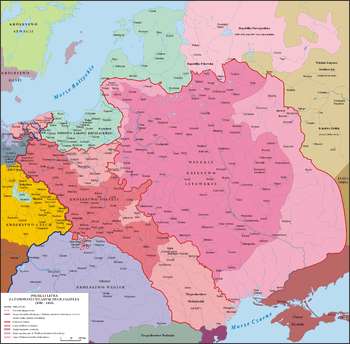Pact of Vilnius and Radom

The Pact of Vilnius and Radom (Polish: Unia wileńsko-radomska, Lithuanian: Vilniaus-Radomo sutartis) was a set of three acts passed in Vilnius, Grand Duchy of Lithuania, and confirmed by the Crown Council in Radom, Kingdom of Poland in 1401. The union amended the earlier act of the Union of Krewo (1385) and confirmed the Ostrów Agreement (1392). Vytautas, Grand Duke of Lithuania, became fully in charge of the Lithuanian affairs, while Władysław II Jagiełło, King of Poland, reserved the rights of an overlord. After the death of Vytautas, Lithuania was to be ruled by Władysław II Jagiełło or his legal heir. The union is generally seen as strengthening of the Polish–Lithuanian union.[1]
Background
Both Władysław II Jagiełło, King of Poland, and Vytautas, Grand Duke of Lithuania, sought to renew the Polish–Lithuanian union, which had existed since 1385. In 1399, Queen Jadwiga of Poland died due to childbirth complications, leaving Władysław II Jagiełło king of a foreign land and without an heir.[2] If Polish nobles forced Władysław II Jagiełło to abdicate the throne, he would return to Lithuania demanding the throne of the Grand Duke. Vytautas would be forced either to return to Duchy of Trakai or launch another civil war.[3] The same year Vytautas suffered a major defeat in the Battle of the Vorskla River against the Golden Horde[4] and faced rebellions in the Principality of Smolensk, Republic of Pskov, and Velikiy Novgorod.[5]
Provisions
Negotiations began in late December 1400 in Hrodna. The union was signed in three separate acts: one by Władysław II Jagiełło (the original of which did not survive), another by Vytautas and the Lithuanian nobles (in Vilnius on 18 January 1401), and the third by the Polish Royal Council (in Radom on 11 March 1401).[2] It is significant that for the first time the Lithuanian nobles issued a political act in their own name, not merely as witnesses to the Grand Duke's treaties.[6]
Vytautas was instituted as the Grand Duke of Lithuania (magnus dux) while his cousin Władysław II Jagiełło, King of Poland, retained the rights of an overlord (supremus dux).[7] The union legalized the Grand Duchy's independence leaving Vytautas fully in charge of all Lithuanian affairs.[6] However, this independence was to be temporary – after Vytautas' death Lithuania was to be governed by Władysław II Jagiełło or his legal heir. The Polish and Lithuanian nobles agreed not to elect a new King of Poland without consulting each other.[6] At the time neither Władysław II Jagiełło nor Vytautas had heirs, but each hoped to sire legitimate sons that would inherit both the Kingdom of Poland and the Grand Duchy (eventually it would be Jogaila who would succeed in this).[8]
Aftermath and evaluations
The renewed alliance stabilized the situation, allowing Vytautas to launch an offensive against the Teutonic Knights and to initiate the first Samogitian uprising.[4] Eventually, the joint Polish–Lithuanian forces achieved a decisive victory against the Knights in the Battle of Grunwald in 1410. The treaty has been variously interpreted by Lithuanian and Polish historians. Some argued that it was a diplomatic failure on Vytautas' part, as the union blocked the path to his possible coronation as King of Lithuania.[2] Others saw it as a concession by the Poles when their plan to fully incorporate the Grand Duchy into the Kingdom of Poland failed.[2] A third school of thought considered the union to be a mutual compromise: Lithuania abandoned plans for full independence, while Poland abandoned plans for full incorporation of Lithuania into a unitary state.[3] More recent academic works tend not to overestimate the union's importance and see it as mere codification of the actual Polish–Lithuanian relations that had existed since 1392.[2]
References
- ↑ Sedlar, Jean W. (1994). East Central Europe in the Middle Ages, 1000–1500. History of East Central Europe. 3. University of Washington Press. p. 388. ISBN 0-295-97290-4.
- 1 2 3 4 5 Kiaupa, Zigmantas; Jūratė Kiaupienė; Albinas Kunevičius (2000) [1995]. The History of Lithuania Before 1795 (English ed.). Vilnius: Lithuanian Institute of History. pp. 135–137. ISBN 9986-810-13-2.
- 1 2 Pficneris, Jozefas (1989) [1930]. Didysis Lietuvos kunigaikštis Vytautas kaip politikas (in Lithuanian). Vilnius: Mintis. pp. 153–154. ISBN 5-417-02852-5.
- 1 2 Stone, Daniel (2001). The Polish–Lithuanian State, 1386–1795. A History of East Central Europe. University of Washington Press. pp. 10–11. ISBN 0-295-98093-1.
- ↑ (Lithuanian) Ivinskis, Zenonas (1978). Lietuvos istorija iki Vytauto Didžiojo mirties. Rome: Lietuvių katalikų mokslo akademija. p. 319. LCC 79346776.
- 1 2 3 Petrauskas, Rimvydas; Jūratė Kiaupienė (2009). Lietuvos istorija. Nauji horizontai: dinastija, visoumenė, valstybė (in Lithuanian). IV. Baltos lankos. pp. 357–358. ISBN 978-9955-23-239-1.
- ↑ Kiaupa, Zigmantas; Jūratė Kiaupienė; Albinas Kunevičius (2000) [1995]. The History of Lithuania Before 1795 (English ed.). Vilnius: Lithuanian Institute of History. p. 154. ISBN 9986-810-13-2.
- ↑ Lukowski, Jerzy; Hubert Zawadzki (2006). A Concise History of Poland. Cambridge University Press. p. 44. ISBN 0-521-85332-X.